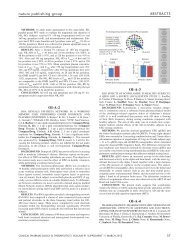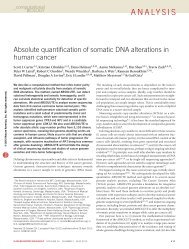open access: Nature Reviews: Key Advances in Medicine
open access: Nature Reviews: Key Advances in Medicine
open access: Nature Reviews: Key Advances in Medicine
Create successful ePaper yourself
Turn your PDF publications into a flip-book with our unique Google optimized e-Paper software.
CLINICAL ONCOLOGY<br />
high-dose chemo therapy with carmust<strong>in</strong>e,<br />
etoposide, cytarab<strong>in</strong>e, and melph alan<br />
plus autologous hemato poietic stem-cell<br />
support. After completion of treatment<br />
<strong>in</strong>clud<strong>in</strong>g the salvage therapy, the 7-year<br />
rate of overall survival was 89% <strong>in</strong> patients<br />
<strong>in</strong>itially treated with BEACOPP compared<br />
to 84% <strong>in</strong> patients who had received ABVD.<br />
As this difference <strong>in</strong> overall survival was not<br />
significant, the authors concluded that treatment<br />
with BEACOPP resulted <strong>in</strong> a more<br />
effective disease control, but not <strong>in</strong> a better<br />
long-term outcome, compared with ABVD.<br />
They argued that while a major proportion<br />
of patients could be cured by the <strong>in</strong>itial<br />
BEACOPP therapy, this cl<strong>in</strong>ical benefit<br />
might be neutralized by a high rate of longterm<br />
adverse events, <strong>in</strong> particular myelotoxicity,<br />
<strong>in</strong>fections and secondary neoplasias.<br />
Viviani et al. 8 deduced that the BEACOPP<br />
regimen presents an over treatment strategy<br />
for a large number of patients and<br />
recommended ABVD for patients with<br />
advanced-stage or unfavorable Hodgk<strong>in</strong><br />
lymphoma. This study has triggered an<br />
<strong>in</strong>tense discussion about the need for an<br />
<strong>in</strong>tensive BEACOPP therapy <strong>in</strong> advancedstage<br />
Hodgk<strong>in</strong> lymphoma, as few patients<br />
who relapse can be rescued with a high-dose<br />
salvage therapy. However, this trial 8 was not<br />
powered to demonstrate a survival difference<br />
between the two treatments and the 7-year<br />
overall survival differed by 5% <strong>in</strong> favor of<br />
the BEACOPP regimen. Moreover, median<br />
observation time (61 months) and the<br />
number of patients were low. As a result, an<br />
appropriate treatment <strong>in</strong>tensity <strong>in</strong> advancedstage<br />
or unfavorable Hodgk<strong>in</strong> lymphoma is<br />
still debated.<br />
The improvements <strong>in</strong> our understand<strong>in</strong>g of<br />
the molecular pathogenesis of non-Hodgk<strong>in</strong><br />
lymphoma have led to the develop ment of<br />
novel therapeutic agents that <strong>in</strong>terfere with<br />
signal<strong>in</strong>g pathways <strong>in</strong>volved <strong>in</strong> lymphomagenesis.<br />
For <strong>in</strong>stance, the addition of the<br />
proteasome <strong>in</strong>hibitor bortezomib enhanced<br />
the activity of chemo immunotherapy with<br />
R-CHOP as first-l<strong>in</strong>e treatment for diffuse<br />
large B-cell lymphoma (DLBCL) and mantle-<br />
cell lymphoma. 9 Ruan et al. 9 demon strated<br />
that, <strong>in</strong> particular, patients with a nongerm<strong>in</strong>al<br />
center B-cell-like (GCB) subtype,<br />
which is usually associ ated with a worse<br />
outcome, benefit from the addition of bortezomib.<br />
This <strong>in</strong>creased cl<strong>in</strong>ical benefit can<br />
be expla<strong>in</strong>ed by the fact that the non-GCB<br />
subtype is characterized by a deletion <strong>in</strong> a<br />
tumor-suppressor gene that activates NF-κB<br />
and this activation is blocked by bortezomib.<br />
Thus, a worse prognosis <strong>in</strong> this subgroup of<br />
patients with DLBCL could be overcome by<br />
bortezomib treatment.<br />
Overall, 2011 saw excit<strong>in</strong>g developments<br />
<strong>in</strong> the understand<strong>in</strong>g and treatment of B-cell<br />
lymphomas. Whereas research <strong>in</strong> Hodgk<strong>in</strong><br />
lymphoma aims to reduce the adverse effects<br />
of first-l<strong>in</strong>e treatment, <strong>in</strong> most other lymphomas<br />
more-effective therapies are needed.<br />
The grow<strong>in</strong>g understand<strong>in</strong>g of the pathogenesis<br />
of these lymphomas will facilitate<br />
the develop ment of novel therapeutic agents.<br />
Department of Internal Medic<strong>in</strong>e I and Center<br />
for Integrated Oncology Köln-Bonn, University of<br />
Cologne, Joseph-Stelzmann-Straße. 9, 50924<br />
Cologne, Germany (P. Cramer, M. Hallek).<br />
Correspondence to: M. Hallek<br />
michael.hallek@uni-koeln.de<br />
Compet<strong>in</strong>g <strong>in</strong>terests<br />
M. Hallek declares associations with the follow<strong>in</strong>g<br />
companies: Celgene, Mundipharma, Roche. See the<br />
article onl<strong>in</strong>e for full details of the relationships.<br />
P. Cramer declares no compet<strong>in</strong>g <strong>in</strong>terests.<br />
1. Kikushige, Y. et al. Self-renew<strong>in</strong>g hematopoietic<br />
stem cell is the primary target <strong>in</strong> pathogenesis<br />
of human chronic lymphocytic leukemia. Cancer<br />
Cell 20, 246–259 (2011).<br />
2. Puente, X. S. et al. Whole-genome sequenc<strong>in</strong>g<br />
identifies recurrent mutations <strong>in</strong> chronic<br />
lymphocytic leukaemia. <strong>Nature</strong> 475, 101–105<br />
(2011).<br />
3. Wang, L. et al. SF3B1 and other novel cancer<br />
genes <strong>in</strong> chronic lymphocytic leukemia. N. Engl.<br />
J. Med. http://dx.doi.org/10.1056/<br />
NEJMoa1109016.<br />
4. Salles, G. et al. Rituximab ma<strong>in</strong>tenance for<br />
2 years <strong>in</strong> patients with high tumor burden<br />
follicular lymphoma respond<strong>in</strong>g to rituximab<br />
plus chemotherapy (PRIMA): a phase 3,<br />
randomised controlled trial. Lancet 377, 42–51<br />
(2011).<br />
5. Bachy, E. et al. Long-term follow-up of patients<br />
with newly diagnosed follicular lymphoma <strong>in</strong> the<br />
prerituximab era: effect of response quality on<br />
survival - a study from the Groupe d’Etude des<br />
Lymphomes de l’Adulte. J. Cl<strong>in</strong>. Oncol. 28,<br />
822–829 (2010).<br />
6. Engert, A. et al. Reduced treatment <strong>in</strong>tensity <strong>in</strong><br />
patients with early-stage Hodgk<strong>in</strong>’s lymphoma<br />
N. Engl. J. Med. 363, 640–652 (2010).<br />
7. Borchmann, P. et al. Eight cycles of escalateddose<br />
BEACOPP compared with four cycles of<br />
escalated-dose BEACOPP followed by four<br />
cycles of basel<strong>in</strong>e-dose BEACOPP with or<br />
without radiotherapy <strong>in</strong> patients with advancedstage<br />
Hodgk<strong>in</strong>’s lymphoma: f<strong>in</strong>al analysis of<br />
the HD12 trial of the German Hodgk<strong>in</strong> Study<br />
Group. J. Cl<strong>in</strong>. Oncol. 29, 4234–4242 (2011).<br />
8. Viviani, S. et al. ABVD versus BEACOPP for<br />
Hodgk<strong>in</strong>’s lymphoma when high-dose salvage<br />
is planned. N. Engl. J. Med. 365, 203–212<br />
(2011).<br />
9. Ruan, J. et al. Bortezomib plus CHOP-rituximab<br />
for previously untreated diffuse large B-cell<br />
lymphoma and mantle cell lymphoma. J. Cl<strong>in</strong>.<br />
Oncol. 29, 690–697 (2011).<br />
MELANOMA IN 2011<br />
A new paradigm tumor for drug<br />
development<br />
Alexander M. M. Eggermont and Carol<strong>in</strong>e Robert<br />
Melanoma has emerged as the paradigm tumor for drug development<br />
through mutation-targeted therapies (<strong>in</strong>hibitors target<strong>in</strong>g BRAF, MEK, and<br />
c-KIT) and immunotherapy. Explor<strong>in</strong>g the comb<strong>in</strong>ations of both approaches<br />
is a challenge that will require scientific rationale and the cooperation of<br />
the pharmaceutical <strong>in</strong>dustry. But, with these challenges comes another<br />
opportunity to change the paradigms <strong>in</strong> drug development.<br />
Eggermont, A. M. M. & Robert, C. Nat. Rev. Cl<strong>in</strong>. Oncol. 9, 74–76 (2012); published onl<strong>in</strong>e 10 January 2012;<br />
doi:10.1038/nrcl<strong>in</strong>onc.2011.201<br />
For the past 40 years no treatments developed<br />
for melanoma have significantly<br />
improved survival over dacarbaz<strong>in</strong>e, a drug<br />
with a response rate of around 10%. In the<br />
past decade, we have witnessed—<strong>in</strong> the fields<br />
of mutation-driven drug development and<br />
immuno modulation—the establishment of<br />
treatments actively impact<strong>in</strong>g survival. This<br />
is just the beg<strong>in</strong>n<strong>in</strong>g of a promis<strong>in</strong>g journey<br />
to develop rational and biology-driven treatments<br />
for patients with melanoma with cl<strong>in</strong>ically<br />
significant impact to greatly change the<br />
thera peutic landscape.<br />
The treatment of melanoma has evolved<br />
from us<strong>in</strong>g non-selective <strong>in</strong>hibitors to more<br />
selective agents, with BRAF, MEK and c-KIT<br />
<strong>in</strong>hibitors lead<strong>in</strong>g the field. BRAF mutations<br />
are the most frequently occurr<strong>in</strong>g and most<br />
important mutations that provide drugable<br />
targets <strong>in</strong> melanoma. The first selective<br />
BRAF <strong>in</strong>hibitor developed <strong>in</strong> the cl<strong>in</strong>ical<br />
sett<strong>in</strong>g was vemurafenib. 1 In a randomized<br />
phase III trial published <strong>in</strong> 2011, this<br />
drug led to major tumor responses <strong>in</strong> 50%<br />
of patients, and m<strong>in</strong>or responses <strong>in</strong> >30% of<br />
patients. 2 The most common adverse events<br />
were arthralgia, fatigue, and cutaneous<br />
mani festations such as rash, photo sensitivity,<br />
pruritis, and squamous-cell carc<strong>in</strong>oma of<br />
the keratoacanthoma-type <strong>in</strong> around 20%<br />
S16 | JANUARY 2012 www.nature.com/reviews








